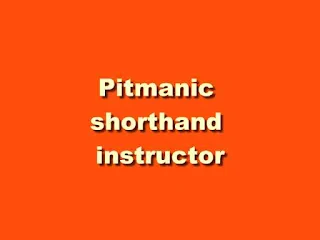Pitmanic shorthand instructor - PDF ebook
Pitman shorthand is a system of shorthand for the English language developed by Englishman Sir Isaac Pitman, who first presented it in 1837. Like most systems of shorthand, it is a phonetic system; the symbols do not represent letters, but rather sounds, and words are, for the most part, written as they are spoken
From introduction:
One plan for teaching shorthand is to rush the pupils through the principles (it can be done in less than two weeks), and then build the reporting ideas upon this foundation. Another way is to allow the student to thoroughly "soak" in the principles (say, for a couple of months) before beginning to erect the reporting superstructure.
The author has tried both methods during the past fifteen years, and his verdict is emphatically in favour of the latter plan; the student reaches the goal of proficiency quicker this way than by any other. This book conforms to the latter method. 6. As to the merits of Pitmanic Shorthand, no argument is needed here.
That it is inherently adapted to meet all the needs of verbatim reporting is being constantly demonstrated in the business house, in the courts, in the legislatures, and in congress. And it has for its 'exponents some of the most brilliant reporters in the world, such as David Wolfe Brown, and Fred. Ireland, Isaac Dement, etc.
In comparing systems, their practical value is the main point rather than any small difference in time during the learning stage. (See " My Kindergarten," on page 275.) 7. As to the " style " of the Pitmanic Shorthand presented in this book, there are but few important variations from orthodox Benn Pit- man forms, and these result mainly from the effort to remove shorthand from the realm of the purely mechanical and to elevate it to the plane of a science. The spoken syllable is the basis of phonographic representation, and scientific shorthand makes its material conform to this idea as far as rationally possible. Having established a relationship between the spoken syllable and the shorthand equivalent, the learner is then prepared to write almost any word a long word, as a rule, being merely a combination of syllables.
This, with some slight qualifications, is the scientific plan it matters not whether you call it the " syllable method," the " word method," or whatnot. If strict adherence to rules (which stamps it as a science) occasionally imposes a manual check, it on the other hand gives mental impetus and a general averaging will show not only no loss of speed but also a great gain in legibility and quickness of learning.
8. (a) Catering to this syllabic representation results in any unusually strict application of the rules governing the writing of R, L, and SH, which are formulated as follows: vi () Write downward when immediately following an initial vowel (as in " ark," " elm," etc.), or when the last stem-consonant and not followed by a vowel sound (as in " pile," " piles," " piled "; " pair," " pairs," " paired," etc.). (c) Write upward when the first sound in a word (as in " rake," " lame," etc.), or when the last stem-consonant and followed by a vowel sound (as in " pillow," " pillows," " pallets;" " tarry," " tarries," " turrets," etc.).


